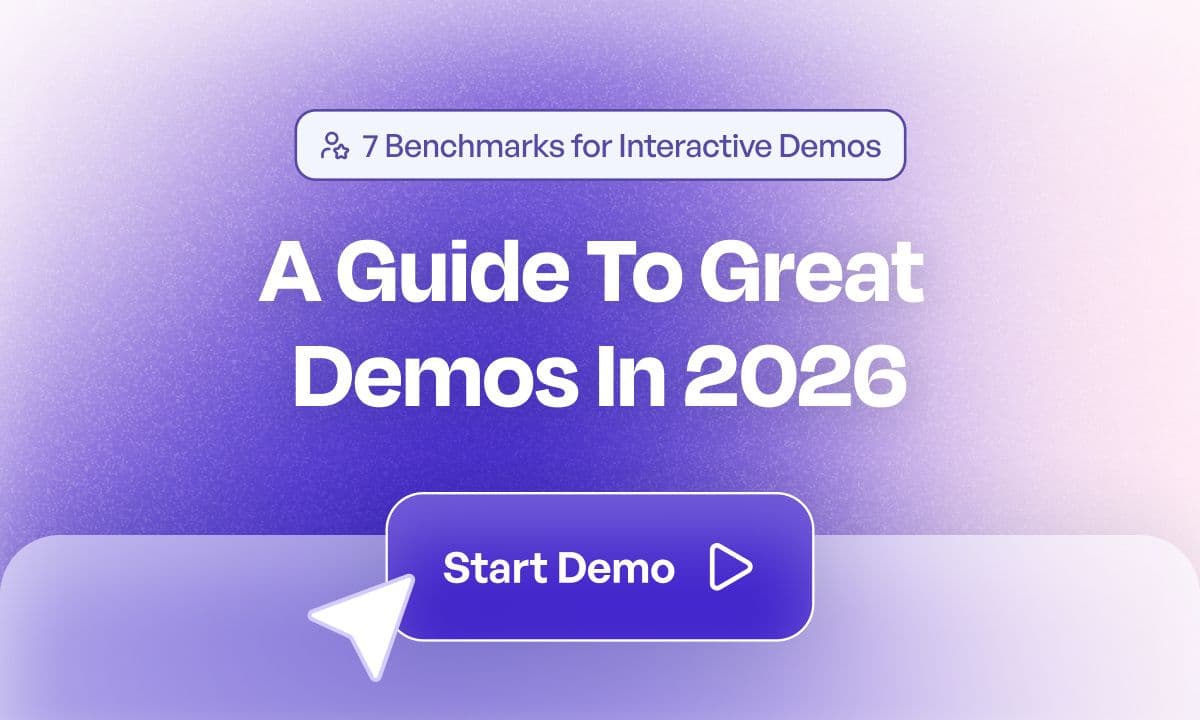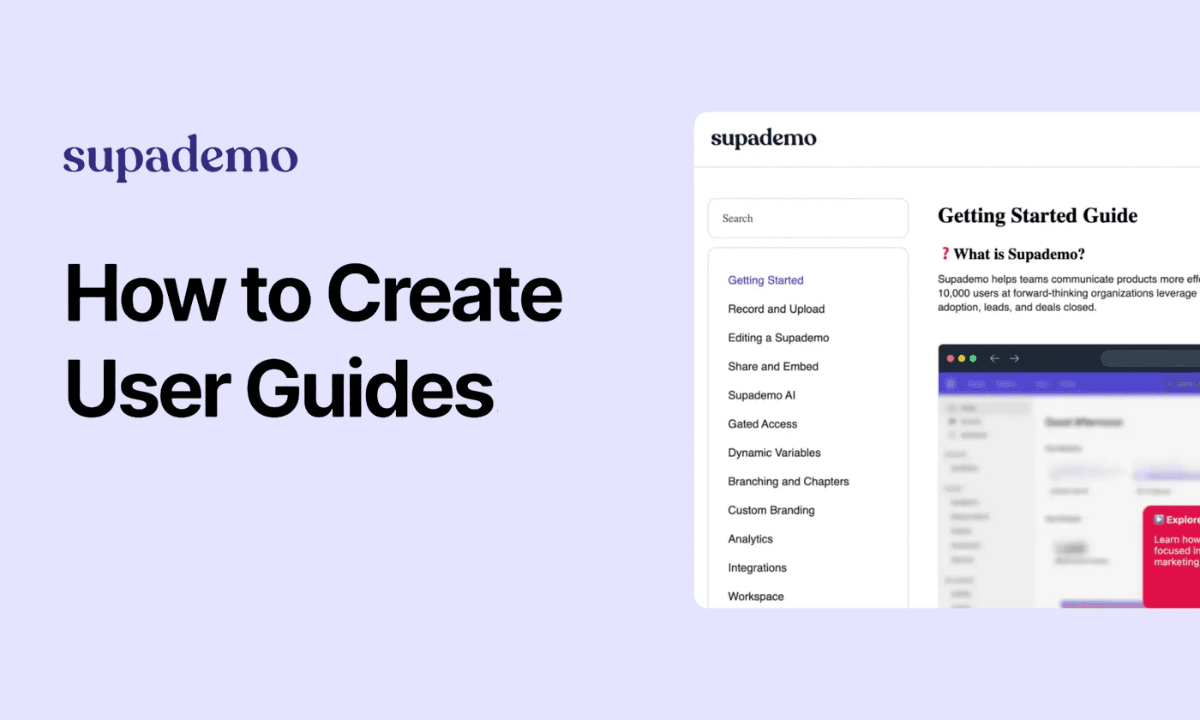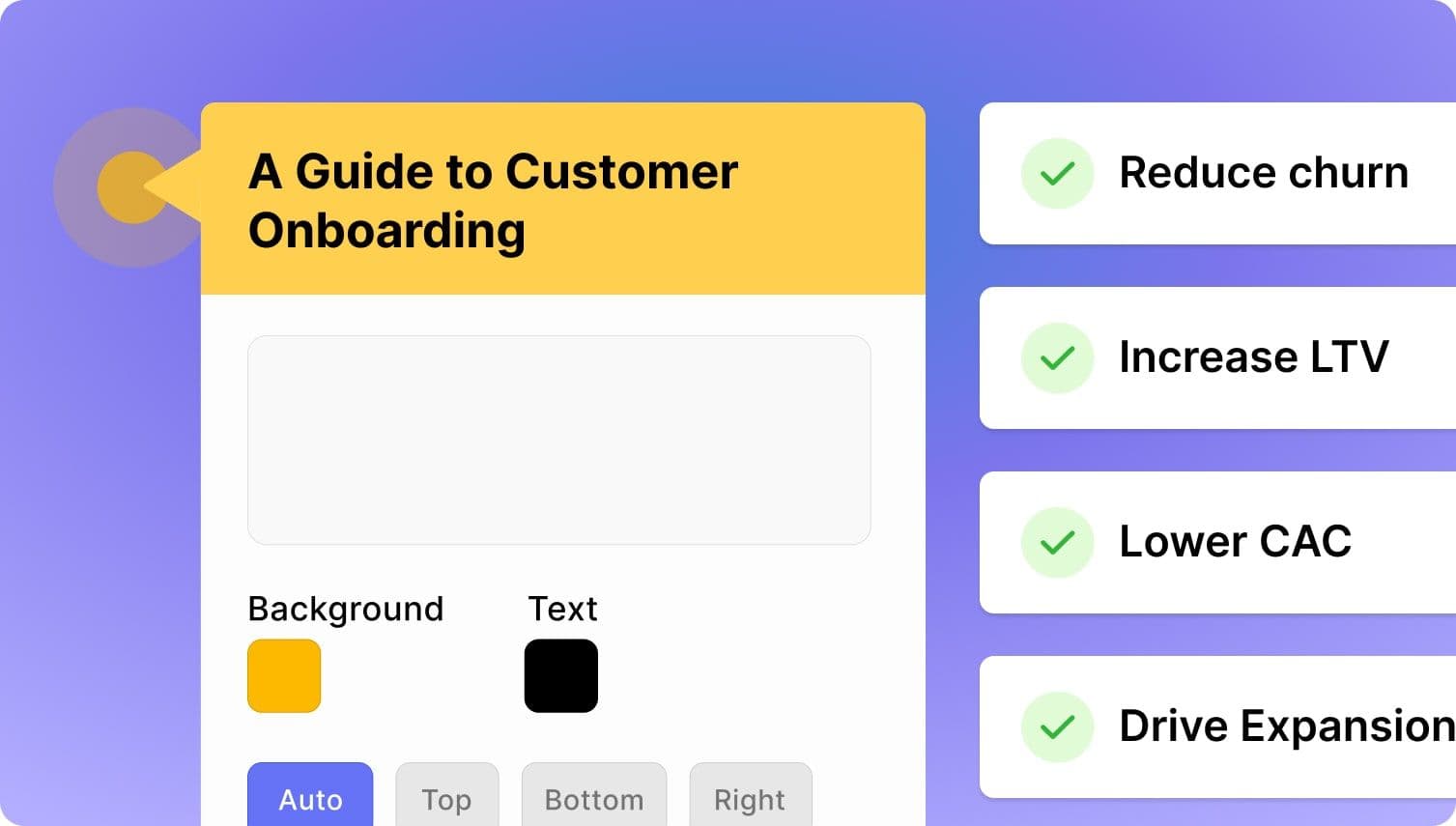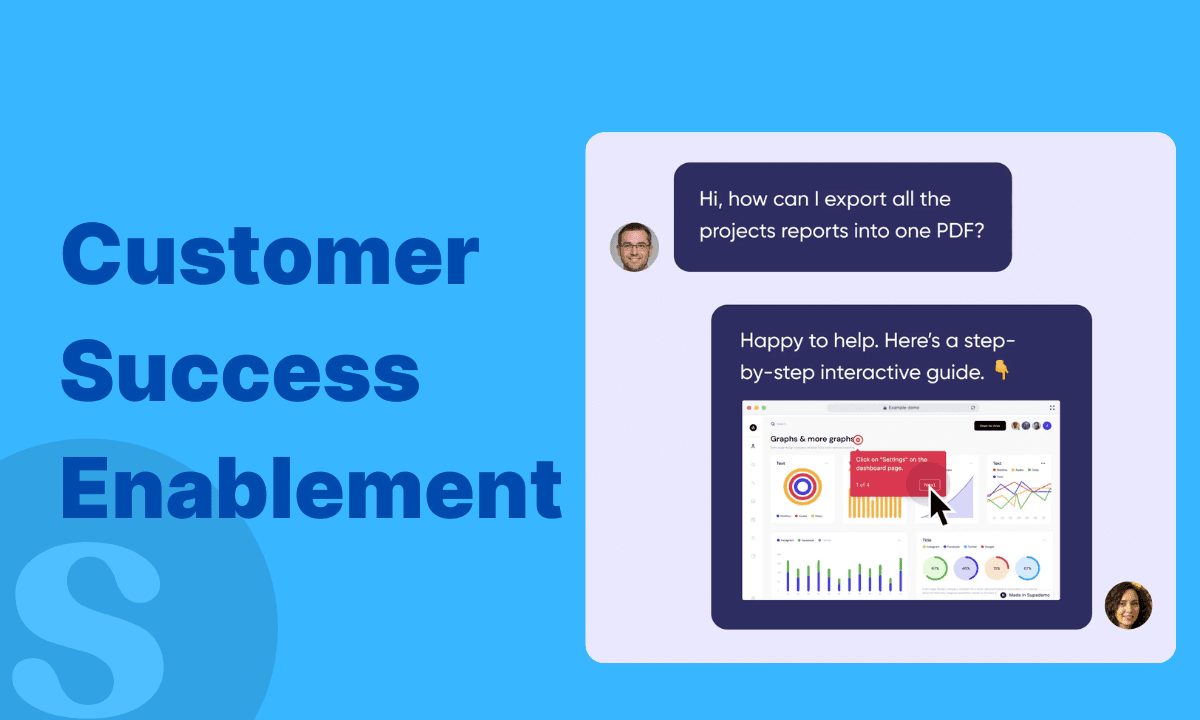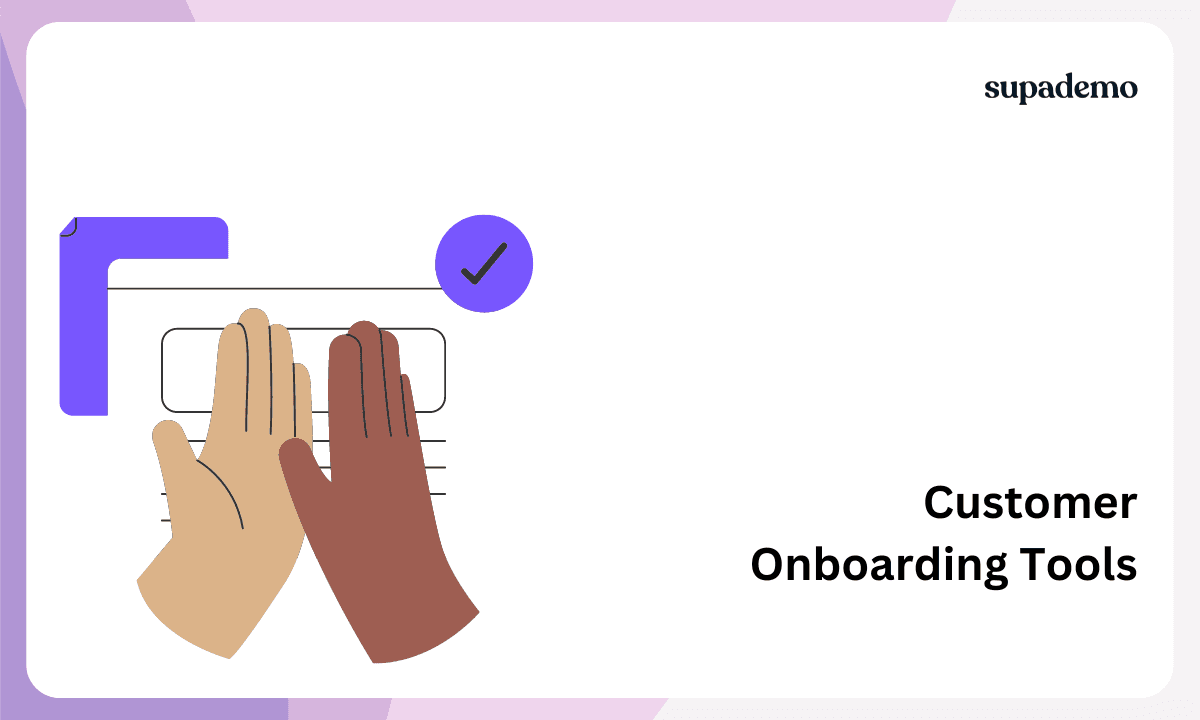
First impressions matter, especially when new customers are using your product. That's where customer onboarding tools come in. These tools make it easy for users to get started and find value quickly.
In 2024, the right onboarding tool can make a big difference. It can turn new users into happy, long-term customers. But with so many options out there, how do you choose?
This article cuts through the noise. We'll look at the top 10 customer onboarding tools available this year. You'll learn what makes each one special and how they can help your business grow.
What Do Customer Onboarding Tools Do?
Customer onboarding tools are powerful allies in guiding new users through your product's features and capabilities. These tools play a crucial role in ensuring that customers quickly grasp the value of your offering and start using it effectively.
“Everyone is busy, so most new users fall through the cracks; for most software products, 40% to 60% of users will sign up once and never come back.”, Ramli John, Author of Product-Led Onboarding: How to Turn New Users Into Lifelong Customers
At their core, customer onboarding tools serve several key functions:
- Streamline the learning process: They break down complex features into digestible steps, making it easier for users to understand and adopt your product.
- Accelerate time-to-value: By guiding users to key features quickly, these tools help customers experience the benefits of your product faster, increasing the likelihood of long-term engagement.
- Personalize the user experience: Many onboarding tools allow for customized journeys based on user roles, preferences, or goals, ensuring relevance and maximizing impact.
- Provide interactive guidance: Through features like tooltips, walkthroughs, and product tours, these tools offer hands-on learning experiences within the product interface.
- Offer self-service resources: Knowledge bases, video tutorials, and FAQs empower users to find answers independently, reducing support costs and improving user satisfaction.
- Facilitate communication: Onboarding tools often include features for sending targeted emails, in-app messages, and notifications to keep users engaged and informed throughout their journey.
- Track and analyze user progress: Many tools provide analytics capabilities, allowing you to monitor user engagement, identify bottlenecks, and continuously improve your onboarding process.
- Encourage feature adoption: By highlighting new or underutilized features, these tools can increase overall product usage and customer retention.
💯
The ultimate goal of customer onboarding tools is to guide users to their "aha moment"
– that pivotal instance when they truly realize the value your product brings to their work or life.

By effectively leveraging these tools, you can create a smooth, engaging product-led onboarding experience that sets the stage for long-term customer success and loyalty.
The Best Customer Onboarding Tools for SaaS 2024
1. Arrows - Customer onboarding portal
Arrows is a powerful platform designed to make customer onboarding a team effort. It helps businesses guide users through their product efficiently, encouraging task completion and driving engagement.
Key Features Of Arrows:
- Collaborative Workflows: Enable team members to work together on onboarding plans.
- Task Management: Create and assign tasks to guide customers through the onboarding process.
- Progress Tracking: Monitor customer progress in real-time.
- HubSpot Integration: Automate onboarding steps and gather valuable data.
- Engagement Tools: Send timely reminders and nudges to keep customers on track.
2. WalkMe - Product adoption tool
WalkMe is a digital adoption platform that helps businesses enhance user onboarding, training, and support. With WalkMe, businesses can create interactive and personalized onboarding experiences, automate repetitive tasks, and provide on-demand support to users.
Key Features of WalkMe
- Interactive onboarding experiences: WalkMe enables businesses to create interactive onboarding experiences that guide users through their products or services. This helps to reduce the learning curve and increase user adoption.
- Task automation: WalkMe offers task automation capabilities, allowing businesses to automate repetitive tasks and processes. This helps to improve efficiency and productivity during the onboarding process.
- Contextual help and support: WalkMe provides contextual help and support features that allow users to access on-demand assistance directly within the product. This helps to reduce support requests and enhance the overall user experience.
- Data-driven insights and analytics: WalkMe offers detailed analytics and insights into user behavior and engagement during the onboarding process. This data can be used to optimize the onboarding flow and drive continuous improvement.
3. Pendo - Product analytics and user feedback platform
Pendo is a product experience platform that helps businesses drive user adoption, retention, and growth. With Pendo, businesses can create personalized onboarding experiences, gather user feedback, and track product usage to optimize the onboarding process.
Key Features of Pendo:
- Product analytics: Pendo provides product analytics tools to track user behavior, feature usage, and product adoption, allowing businesses to understand how users engage with their digital products.
- User feedback: Pendo enables businesses to gather feedback from users through surveys, polls, and in-app feedback forms, helping them capture insights and identify areas for improvement.
- Onboarding and guidance: Pendo offers onboarding and guidance features, such as in-app tutorials, tooltips, and walkthroughs, to help users get started with new features and maximize their product experience.
- User segmentation: Pendo allows businesses to segment users based on behavior, demographics, and other criteria, enabling targeted messaging and personalized experiences for different user groups.
- Integration: Pendo integrates with CRM, support, and product management tools, allowing businesses to sync user data and feedback across their organization and drive action based on insights.
4. Userpilot - Product adoption platform
Userpilot is a user onboarding and product adoption platform.
It is best suited for companies looking to streamline onboarding processes, enhance user engagement, and optimize product adoption by leveraging interactive walkthroughs, personalized flows, and data-driven insights to improve the overall user experience.
Key Features of Userpilot:
- User onboarding: Userpilot enables businesses to create personalized onboarding experiences for new users, guiding them through key features and functionalities and helping them get value from the product quickly.
- Product tours: Userpilot offers product tour functionality to highlight key features, demonstrate use cases, and provide step-by-step guidance to users within the product interface.
- In-app messaging: Userpilot allows businesses to send targeted in-app messages, notifications, and announcements to users based on their behaviour, preferences, and lifecycle stage, increasing user engagement and retention.
- User segmentation: Userpilot provides user segmentation capabilities, allowing businesses to segment users based on various criteria, such as behaviour, demographics, and engagement, and deliver personalized experiences accordingly.
- Analytics: Userpilot offers analytics and reporting features to track user onboarding progress, product adoption rates, and engagement metrics, providing insights to optimize onboarding and user experience strategies.
5. Supademo - Interactive product walkthroughs
Supademo offers a range of features to scale product-led onboarding with interactive demos. With Supademo, businesses can create interactive and personalized product walkthroughs, demo environments, and proof of concepts (POCs) for their leads.
This tool is designed to reduce the effort required to create and manage onboarding materials while providing a high level of customization.
Key Features of Supademo:
- Interactive product walkthroughs: Supademo allows businesses to create dynamic and engaging product walkthroughs that guide users through their offerings' key features and functionalities.
- No-Code Demo Creation: Allows users to build interactive demos without any coding knowledge, using an intuitive drag-and-drop interface.
- Personalized demo environments: With Supademo, businesses can create customized demo environments that align with their leads' specific needs and preferences. This helps create a more tailored and relevant onboarding experience.
- Proof of concepts (POCs): Supademo enables businesses to create functional POCs that can be shared with leads to test-drive the product before making a purchase decision. This hands-on experience can significantly increase conversion rates.
- Analytics and insights: Supademo provides detailed analytics and insights into user engagement and behaviour during onboarding. This data can be used to optimize the onboarding flow and improve overall customer success.
Read more -
Better Product Onboarding with Interactive Demos: A Comprehensive Guide
6. Appcues - Product adoption platform
Appcues is a user onboarding and customer engagement platform that helps businesses create personalized onboarding experiences. With Appcues, businesses can guide users through their products, gather user feedback, and drive feature adoption.
Key Features of Appcues:
- Interactive product tours: Appcues enables businesses to create interactive product tours that guide users through key features and functionalities. This helps to reduce the learning curve and increase user engagement.
- User feedback and surveys: Appcues offers user feedback and survey capabilities, allowing businesses to gather valuable insights and feedback from users. This helps to identify areas for improvement and optimize the onboarding process.
- Feature adoption and engagement: Appcues provides features to drive feature adoption and engagement, such as in-app messages, tooltips, and onboarding checklists. This helps to ensure that users get the most value out of the product.
- Data-driven analytics and insights: Appcues offers detailed analytics and insights into user behaviour and engagement during the onboarding process. This data can be used to optimize the onboarding flow and drive continuous improvement.
7. Help Scout - Customer support platform
Help Scout is a customer support platform that includes email-based support, a knowledge base tool, and a shared inbox for customer service professionals.
It is best suited for businesses looking to streamline customer inquiries, manage support tickets efficiently, and enhance communication across various channels in a centralized and collaborative manner.
Key features of Help Scout:
- Ticket management: Help Scout provides a centralized platform for managing customer inquiries and support tickets from multiple channels, including email, chat, and social media, ensuring that no inquiry falls through the cracks.
- Shared inbox: Help Scout offers a shared inbox where teams can collaborate on customer conversations, assign tickets, and track progress, enabling seamless communication and collaboration across teams.
- Knowledge base: Help Scout includes a knowledge base feature where businesses can create and organize articles, FAQs, and resources to help customers find answers to common questions and self-serve support solutions.
- Automation: Help Scout offers automation features such as workflows and rules, allowing businesses to automate repetitive tasks, route tickets to the right teams or agents, and ensure timely responses to customer inquiries.
- Reporting and analytics: Help Scout provides reporting and analytics tools to track key support metrics, monitor team performance, and gain insights into customer satisfaction and support trends.
8. Loom - Create quick product videos
Loom simplifies video creation for customer onboarding. Loom's strength lies in its simplicity, making it perfect for teams who need to create clear, concise visual guides for their users without a steep learning curve. It's an efficient tool for enhancing your onboarding process with visual elements.
Key Features of Loom:
- Screen recording: Loom allows users to record their screen, webcam, or both, making it easy to create video messages, tutorials, demos, and presentations.
- Video editing: Loom offers basic editing features, such as trimming, cropping, and adding text overlays, allowing users to polish their videos before sharing them.
- Instant sharing: Loom provides instant sharing options, allowing users to share their videos via a unique link, embed code, or email, making it easy to distribute videos to colleagues, clients, and partners.
- Viewer analytics: Loom offers viewer analytics, allowing users to track who has viewed their videos, how long they watched, and whether they engaged with the content, providing valuable insights into video performance and viewer engagement.
- Integration: Loom integrates with popular communication and collaboration tools, such as Slack, Gmail, and Trello, allowing users to embed videos directly into their workflows and messages.
9. Customer.io - Email marketing and automation
Customer.io is a customer engagement platform that enables businesses to create and automate multi-channel messaging campaigns across email, SMS, push notifications, in-app messages, and webhooks.
It is designed for marketers and growth teams leveraging customer data to deliver personalized and relevant communications at scale.
Key Features of Customer.io:
- Behavioural targeting: Customer.io enables businesses to send targeted messages to customers based on their behaviour, such as website visits, app usage, or past purchases.
- Personalization: Customer.io allows businesses to personalize messages with dynamic content, including product recommendations, personalized offers, and relevant information based on customer data.
- Lifecycle marketing: Customer.io supports lifecycle marketing campaigns, including onboarding sequences, reactivation campaigns, and retention efforts, to engage customers at every customer journey stage.
- Automation: Customer.io provides automation tools for creating and executing marketing campaigns. It allows businesses to set up triggered messages, drip campaigns, and workflows based on customer actions and events.
- Analytics and reporting: Customer.io offers analytics and reporting features to track campaign performance, measure engagement, and identify opportunities for optimization and improvement.
10. Mixpanel: Analyze new user behaviour
Mixpanel is a product analytics platform that helps businesses analyze how users interact with their websites and applications.
By providing a clear picture of user behaviour, Mixpanel empowers teams to create onboarding experiences that truly resonate with new users. This targeted approach can lead to higher adoption rates and improved long-term user satisfaction.
Key Features of Mixpanel:
- Event-based analytics: Mixpanel allows businesses to track user interactions with their products at a granular level by capturing events such as clicks, sign-ups, and purchases.
- Funnel analysis: Mixpanel's funnel analysis tools enable businesses to visualize and analyze the steps users take to complete a desired action, such as making a purchase or signing up for a service.
- Cohort analysis: Mixpanel allows businesses to segment users into cohorts based on shared characteristics or behaviours, making it easier to analyze and compare user engagement over time.
Check out
- a community-sourced, curated directory that simplifies the way you discover, evaluate and choose your next
. You can explore each tool through a series of interactive product demos before you commit to a discovery call, gated trial, or sales demo.
Why use Customer Onboarding Tools: Benefits of Customer Onboarding Tools
Implementing customer onboarding tools offers numerous advantages that can significantly impact your business's success. Let's explore the key benefits:
1. Accelerated Product Adoption
Customer onboarding tools help users quickly understand and leverage your product's features. This rapid familiarization leads to:
- Increased user engagement from day one
- Faster realization of product value
- Higher conversion rates from free trials to paid subscriptions
- Improved upsell opportunities for freemium models
2. Enhanced User Retention
By guiding users to success early in their journey, these tools contribute to:
- Reduced churn rates
- Increased customer lifetime value
- Stronger user loyalty and brand advocacy
3. Reduced Support Burden
Effective onboarding minimizes the need for extensive customer support by:
- Preemptively addressing common user questions
- Providing self-service resources for troubleshooting
- Decreasing support ticket volume and associated costs
4. Personalized User Experiences
Many onboarding tools allow for customization, resulting in:
- Tailored guidance based on user roles or objectives
- More relevant and engaging onboarding journeys
- Improved overall user satisfaction
5. Data-Driven Insights
Onboarding tools often come with analytics capabilities, offering:
- Valuable insights into user behavior and preferences
- Opportunities to identify and address pain points in the user journey
- Data to inform continuous product improvements
6. Competitive Advantage
A smooth onboarding experience can set your product apart by:
- Creating a positive first impression
- Reducing friction in the early stages of product use
- Encouraging word-of-mouth referrals from satisfied users
7. Scalable Growth
As your user base expands, onboarding tools help maintain quality by:
- Automating key aspects of the onboarding process
- Ensuring consistency in the user experience
- Allowing your team to focus on strategic initiatives rather than repetitive tasks
By leveraging customer onboarding tools, you're not just introducing users to your product – you're setting the stage for long-term success, both for your customers and your business. The initial investment in these tools can lead to substantial returns through improved adoption, retention, and overall customer satisfaction.
Also read:
Tactics for Better Onboarding: How We Increased Activation by 20%
Wrapping Up!
Customer onboarding tools play a crucial role in helping businesses create personalized and seamless onboarding experiences for their users.
The customer onboarding tools listed here offer a wide range of features and capabilities to optimize the onboarding process and drive user adoption, engagement, and retention.
By leveraging these tools, businesses can enhance the overall customer experience and maximize the value of their products or services.
Rachel Witt
Rachel is a GTM marketer with 5+ years of experience working at various fast-growing technology companies.
